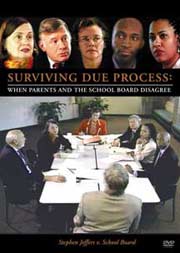|
|
In this issue of The Special Ed Advocate, we'll tell you about a very important case that will be decided by the Supreme Court this year. 
You'll learn how the case began, evolved, and why it is so significant. We'll suggest that you do a little heavy reading - and why you'll be glad you did.
We'll also discuss what may be a new trend in special education law. Feel free to forward this issue of the Special Ed Advocate to a friend.
Sign up free today! l Read previous issues |
|
| Supreme Court to Hear Oral Argument in New Case |
On Monday, October 1, 2007, the U.S. Supreme Court will hear oral argument in New York City Board of Education v. Tom F., on Behalf of Gilbert F., a Minor Child.
The Court will decide whether all children with disabilities, including those who are enrolled in private programs, are entitled to a free appropriate public education (FAPE). The decision will have significant implications for parents, school districts, and children with disabilities who receive special education services.
History
The case came before the Supreme Court after the U.S. Court of Appeals for the Second Circuit vacated and remanded the decision by the District Court.
The Second Circuit held that the IDEA was not meant to deny reimbursement to students who have never been enrolled in public school. To rule otherwise would require parents to enroll their children in inappropriate public school programs before they could be eligible for tuition reimbursement.
In New York City Bd of Ed. v. Tom F., the Supreme Court will determine if a child will be forced to "try" an inappropriate placement before the parents can remove the child to an appropriate placement and seek reimbursement.
Significance
If the Supreme Court affirms the decision by the Second Circuit, parents will have the right to obtain reimbursement from the school district, even if their child was never enrolled in a public school special education program.
If the Supreme Court reverses the Second Circuit, parents will have two choices:
they can place their child in an appropriate private program and forfeit any chance to obtain reimbursement, or they can place their child into an inappropriate public school program so they can later remove the child from that program and seek reimbursement.
For a summary of the NYC v. Tom F., question presented, significance, and links to the briefs filed by the parties, read Supreme Court to Hear Oral Argument in New Tuition Reimbursement Case.
Amicus Briefs
The article also includes links to the amicus ("friend of the court) briefs filed by organizations on behalf of Tom F., Gilbert F, and the NYC Board of Education. Amicus briefs provide additional information on specific areas of law or other aspects of the case to assist the Court in the decision-making process.
Amicus briefs have been filed in support of Tom F. and Gilbert F. by the Solicitor General of the United States,the Council of Parent Attorneys and Advocates (COPAA) and New Jersey Special Education Practitioners, the National Disability Rights Network and the New York Lawyers for the Public Interest, the International Dyslexia Association, NAMI, Mental Health America, and The Bazelon Center, and Autism Speaks.
Amicus briefs have been filed in support of New York City Board of Education by the National School Board Association, Great City Schools, New York State School Boards Association, and the U.S. Conference of Mayors, et al.
We encourage you to read a sample of the amicus briefs. You'll find the different perspectives enlightening. After reading amicus briefs, you'll understand the the high stakes in NYC Bd of Ed v. Tom F. |
back to the top |
|
| A Short History of New York Bd of Education v. Tom F. |
A Short History of New York Bd of Education v. Tom F., on Behalf of Gilbert F. describes key events in the case, from Gil's entry into Kindergarten in 1996, evaluations, and the school district's funding of his education at a private special education school.
You'll learn about the decisions by the hearing officer and state review officer, the federal district court's decision and why the case was vacated by the U.S. Court of Appeals for the Second Circuit.
You'll learn why the U.S. Supreme Court grant cert, the question they will resolve, and when oral argument is scheduled.
Most of the facts cited in this article are from the Amicus Brief filed by the Solicitor General of the United States. That is not a typo.
The federal government is supporting Tom F. and Gil in their battle against the New York City Board of Education. |
back to the top |
|
| New Trend in Special Education Law? |
In the 30 years after the special education law was enacted, the high court heard a handful of special education cases.
The most critical are Rowley (1982), Burlington (1985), Honig v. Doe (1988), Florence County v. Shannon Carter (1993), and Cedar Rapids v. Garret F. (1999)
In 2005, that trend changed.
The Court issued decisions in Schaffer v. Weast (2005), Arlington v. Murphy (2006), and Winkelman v. Parma Sch. District (2007). The decision in New York City Bd of Education v. Tom F. will be published before the end of the 2007-2008 term.
More Special Education Caselaw.
|
back to the top
|
| |








